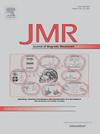使用固态MRI和双调谐射频线圈量化大鼠骨骼中的骨基质和矿物质密度
IF 1.9
3区 化学
Q3 BIOCHEMICAL RESEARCH METHODS
引用次数: 0
摘要
骨组成的定量信息,特别是磷酸钙矿物和有机基质的含量,对于准确诊断代谢性骨疾病(如骨质疏松症、骨软化症和肾性骨营养不良)以及区分这些疾病至关重要。传统的MRI无法提供这些信息,因为这些物质是固体的,因此在传统的MRI扫描中无法产生信号,而传统的MRI扫描通常使用自旋或梯度回波。在本报告中,我们展示了磷和质子固态MRI如何分别使用ZTE和WASPI脉冲序列在骨标本中产生所需的成分信息,并结合使用双端口双调谐螺线管射频线圈。详细介绍了射频线圈的电气网络仿真和结构细节。利用QUCS软件对电路的电气性能进行了模拟,以找出使反射功率最小和使接口隔离最大化的电路元件值。已知成分的幻影,以及正常、低骨密度和维生素d缺乏大鼠的离体股骨,都被纳入研究。对B1非均匀性进行了简单的校正,以实现图像强度值的定量精度。MRI得出的骨基质和矿物质密度与化学分析高度相关(R2 = 0.84),证明了测量骨质疏松症和骨软化症相关成分差异的能力。本文章由计算机程序翻译,如有差异,请以英文原文为准。

Using solid-state MRI and a double-tuned RF coil to quantify bone matrix and mineral densities in rat bones
Quantitative information on the composition of bone, specifically the content of calcium phosphate mineral and organic matrix, is essential for accurate diagnosis of metabolic bone diseases such as osteoporosis, osteomalacia, and renal osteodystrophy, as well as for differentiating among these conditions. Conventional MRI fails to provide this information because these substances are solid and, therefore, yield no signal in conventional MRI scans, which typically employ spin or gradient echoes. In this report, we show how phosphorus and proton solid-state MRI yield the desired compositional information in bone specimens with ZTE and WASPI pulse sequences, respectively, coupled with the use of a two-port double-tuned solenoidal RF coil.
Electrical network simulations and construction details of the RF coil are detailed. Electrical performance was simulated using QUCS software to find the circuit component values that minimize reflected power and maximize interport isolation. Phantoms of known composition, as well as ex vivo femurs from normal, low bone density, and vitamin D-deficient rats, were included in the study. A simple correction for B1 inhomogeneity was applied to achieve quantitative accuracy in the image intensity values.
Bone matrix and mineral densities derived from MRI strongly correlated (R2 = 0.84) with chemical analysis, demonstrating the ability to measure compositional differences relevant to osteoporosis and osteomalacia.
求助全文
通过发布文献求助,成功后即可免费获取论文全文。
去求助
来源期刊
CiteScore
3.80
自引率
13.60%
发文量
150
审稿时长
69 days
期刊介绍:
The Journal of Magnetic Resonance presents original technical and scientific papers in all aspects of magnetic resonance, including nuclear magnetic resonance spectroscopy (NMR) of solids and liquids, electron spin/paramagnetic resonance (EPR), in vivo magnetic resonance imaging (MRI) and spectroscopy (MRS), nuclear quadrupole resonance (NQR) and magnetic resonance phenomena at nearly zero fields or in combination with optics. The Journal''s main aims include deepening the physical principles underlying all these spectroscopies, publishing significant theoretical and experimental results leading to spectral and spatial progress in these areas, and opening new MR-based applications in chemistry, biology and medicine. The Journal also seeks descriptions of novel apparatuses, new experimental protocols, and new procedures of data analysis and interpretation - including computational and quantum-mechanical methods - capable of advancing MR spectroscopy and imaging.

 求助内容:
求助内容: 应助结果提醒方式:
应助结果提醒方式:


